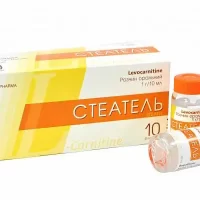$56.10
Manufacturer: Germany
Purpose: Boosts cellular energy production by reducing oxidative stress in diabetic neuropathy.
Description
Thiogamma (α-lipoic acid) tablets 600 mg. №30
Ingredients
Each tablet contains 600 mg of α-lipoic acid.
Dosage
The recommended dosage is one tablet daily, or as directed by a healthcare professional.
Indications
Thiogamma tablets are indicated for the treatment of diabetic neuropathy and as an antioxidant supplement.
Contraindications
Do not use Thiogamma tablets if you are allergic to α-lipoic acid or any other ingredients in the product.
Directions
Take Thiogamma tablets orally with water, preferably with a meal to improve absorption.
Scientific Evidence
α-lipoic acid, the active ingredient in Thiogamma tablets, has been extensively studied for its antioxidant properties and its role in managing diabetic neuropathy. Research has shown that α-lipoic acid can help improve nerve function and reduce symptoms of neuropathy, such as pain and numbness.
Additional Information
Thiogamma tablets are manufactured to high pharmaceutical standards to ensure quality and efficacy. It is important to consult with a healthcare provider before starting any new supplement regimen, especially if you have underlying medical conditions or are taking other medications.
Studies have also suggested that α-lipoic acid may have potential benefits in conditions such as cardiovascular disease and cognitive decline, making it a versatile supplement with promising health implications.
Related products
-

Steatel (levocarnitine) oral solution 1 g/10 ml. vials №10
$49.00 Add to cart -

Stimol (citrullin malate) effervescent powder for oral solution 1 g. sackets №18
$38.00 Add to cart -

Solizim (lipase) coated tablets 20000 IU №20
$7.00 Add to cart -

Thioctodar (α-lipoic acid) solution for injections 3% 10 ml. vial №10
$34.20 Add to cart



Recent Reviews